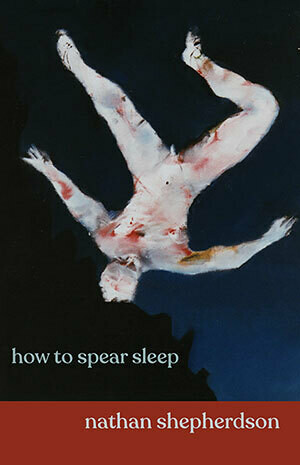how to spear sleep
Nathan Shepherdson
(Shearsman Books, 2021); pbk £10.95
Award-winning poet Nathan Shepherdson guides us atomically through the universe (the entirety of matter and space) where one man – Romanian-born German-language poet and translator Paul Celan – weighs the depth and demand of his relationship with poetry and familial love. Unable to settle on an order of importance, Celan explores the tensions that arise between his roles as poet, husband, and father. Based on conversations between du Bouchet and Celan’s wife Gisèle Celan-Lestrange and son Eric Celan, how to spear sleep dissects Celan’s biblical hallucination; akin to Abraham, he must choose between Poetry and son.
I knew skin
promised more than life[.]
Shepherdson’s narrative voice is defined by Beuysian thought-sculptures, a form derived from the art movement known as Fluxus. Ideated by Joseph Heinrich Beuy, this movement grew out from the idea that social sculpture is ‘gesamtkunstwerk’ (translated literally as ‘total artwork’). In how to spear sleep, Shepherdson harnesses gesamtkunstwerk through autotelic ideographic typographical elements. His poem titles, written as degrees at the top left of the page (i.e., 67°; 39°; 156°), enhance our understanding of the written word. Each degree reiterates its subsequent poem’s individual ‘orbit or oscillation around the [collection’s] original idea.’
While the collection may not appear to have an apparent chronological order, there is intentionality to the way Shepherdson arranged the poems. The complete work might be considered a three-act epic. At the beginning, Celan contemplates and compares three communicative modes: body (‘skin’), voice and written language. Towards the end of the collection, Celan reflects on the distinct consequences that follow each one of these communicative methods, wondering about their autonomous, concurrent influences.
The opening two acts of how to spear death marvel at the way words are inherited and communicated both consciously and subconsciously through memory and physical motion. In a monologue with his unborn son (a scene that puts into contention reflecting on something that is both futuristic and present-tense), Celan details ‘the breeze’ as it ‘moves your mother’s hair to speech.’ Here, skin ‘grow[s] over the traffic of words.’ Celan continues:
For a while, Celan ‘ignore[s] words / for movement.’ His bodily language speaks and ‘listens to the two hearts’ that beat within his wife.
you are the final language
from which I am
removed
from which I
am[.]
Celan writes about his son. But as the narrative moves forward, Shepherdson’s narrator is presented with the collection’s overarching question.
how to decide
which tongue
to place
on the window sill
for prayers to peck at[.]
The tongue holds duality in this poem. It simultaneously represents Celan’s poetic voice as well as the voice of God, who he believes commands him to choose between poetry and the life of his son. In the final act, Shepherdson explicitly reflects on the impact this choice has on Celan. How ‘the skin’ is ‘impossible to buy / until the body is eaten.’ At an apex, Celan cries
my SoN
is TrAPPEd iNSidE
& I doN’T kNow How
To rEACH Him[.]
Maybe this is what Shepherdson means when he writes ‘welcome to the genre of crucifixion.’ A sacrifice must be made for the tongue to move beyond muscular organ, and become vocal in both written word and speech. Could this crucifixional reference suggest the death of genre, where forms crossover and amalgamate; the numerical aspects linked to illustrated circles, and the written word intensified by verbalization? Shepherdson has prepared us for this crucifixion. The title’s mention of ‘spear’ alludes to biblical rendering – a sharp ‘transfiguration’ of the body. In how to spear sleep, Shepherdson examines Celan’s physicality. In the quote above, Celan’s words break apart. His actions and dogmas are warped by interwoven lowercase and capitalized letters until one question remains. To whom does the spirit – poet and philosopher – belong? To oneself or to one’s God?
Shanley McConnell


Leave a Reply